Synthesis of ZnWO4/CdWO4 core–shell structured nanorods formed by an oriented attachment mechanism with enhanced photocatalytic performances
Abstract
ZnWO4/CdWO4 core–shell structured nanorods have been synthesized using a simple refluxing method under mild conditions in which the crystallization event of ZnWO4 happened on the backbone of CdWO4 single crystalline nanorods in a ligand-free system. A CdWO4 nanorod-directed oriented attachment mechanism was clearly observed for the formation of the ZnWO4/CdWO4 core–shell structured nanorods. The size of the ZnWO4 could be tuned by changing the molar ratio of the Zn source and the Cd source. The photocatalytic activity of the ZnWO4/CdWO4 core–shell structured nanorods was much better than for CdWO4. The enhancement in photocatalytic performance was demonstrated to be due to the match in lattice and energy levels between the ZnWO4 and CdWO4. This match facilitated the separation and transfer of photogenerated e−/h+ pairs at the heterojunction interfaces and might be important for other heterostructured materials. Kinetic studies using radical scavenger technologies suggested that photogenerated holes were the dominant photooxidants.


 Please wait while we load your content...
Please wait while we load your content...